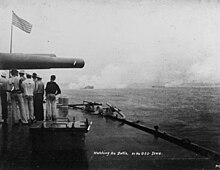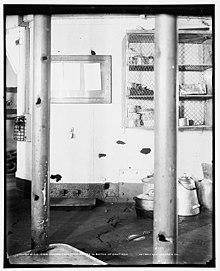Naval battle of Santiago de Cuba
| date | July 3, 1898 |
|---|---|
| place | Santiago de Cuba , Cuba |
| output | Decisive victory for the Americans. |
| consequences | Liberation of Cuba. End of the centuries-old Spanish naval presence in the New World. |
| Parties to the conflict | |
|---|---|
| Commander | |
| Troop strength | |
| 4 armored cruisers 2 torpedo boats |
2 armored cruisers 4 ships of the line 1 auxiliary cruiser 1 gunboat |
| losses | |
|
4 armored cruisers stranded |
1 armored cruiser slightly damaged |
Atlantic Theater of War
Puerto Rico - Guantánamo Bay - El Caney - San Juan Hill - Santiago de Cuba I - Santiago de Cuba II
Pacific theater of war
Manila Bay - Guam - Manila
The Battle of Santiago was a military conflict on July 3, 1898 between naval forces of Spain and the United States before Santiago de Cuba during the Spanish-American War . It ended with the destruction of the Spanish association when they tried to break through the American blockade of the port. As a result of this result, the Spanish armed forces were no longer able to support their forces in Cuba , so that the island fell into American hands a few weeks later.
prehistory
After an initially unexplained explosion of the US American liner USS Maine in the port of Havana on February 15, 1898, war broke out between Spain and the United States at the end of April 1898. After initial successes in East Asia (→ Battle of the Bay of Manila ) US Navy units began operations in the West Indies in May 1898 . The Spanish government therefore sent the newly established 1st Squadron of the Armada Española under Admiral Pascual Cervera to the region, which entered Santiago de Cuba on May 19 . The association had previously tried in vain to take over coal in Fort-de-France ( Martinique ). After Admiral Cervera had given up the intention to march to San Juan , Puerto Rico (since this port was already blocked by the United States Navy ), the 1st Squadron moved to Santiago de Cuba. There, however, the Spanish association was also blocked from the end of May 1898 by a superior fleet squadron of the US Navy under Rear Admiral William T. Sampson (1840-1902). On June 22, 1898, American troops went ashore near Santiago (in Daiquirí ), so that Admiral Cervera was forced to attempt an escape if he did not want to run the risk of his ships getting caught between two fires.
As a result of the inadequate maintenance options, the Spanish ships, the armored cruisers Infanta Maria Teresa ( flagship ), Vizcaya , Cristóbal Colón and Almirante Oquendo, as well as two torpedo boats, were in very poor condition. The hulls were heavily overgrown (which massively reduced the speed of the ships, in combination with the mostly poor quality of the bunker coal). In addition, numerous gun breeches and, as a result of the long storage time, a considerable part of the shell detonators on board the cruisers were defective (almost 50 percent of all Spanish shells that hit a target during the battle turned out to be duds ). The Spanish crews also suffered from the fact that only a few training units had been completed in the pre-war period. The condition of the ships worsened during the 37 days that the Spaniards were trapped in Santiago de Cuba. Overall, the Spanish squadron was only able to fight to a very limited extent.
course
On the morning of July 3, 1898, Admiral Cervera attempted to break through the American blockade, which consisted of the armored cruiser USS Brooklyn and the ships of the line USS Texas , USS Massachusetts , USS Iowa and USS Oregon , an auxiliary cruiser and the gunboat USS Vixen . Since Rear Admiral Sampson was standing too far to the east on the armored cruiser USS New York , Commodore Winfield Scott Schley temporarily led the high command on the Brooklyn at the beginning of the battle. Due to a hasty command to turn in on the enemy, there was almost a collision between the Brooklyn and the Texas in the initial phase of the battle , which initially caused the ship of the line to fall behind the US unit (and which Schley later also received severe criticism).
The Spanish association, headed by the flagship Infanta Maria Teresa , left the port shortly after 9:10 am and navigated west along the coast. As early as 9.30 a.m., the Brooklyn and Iowa came into action with the Spanish top ships. The fire from the US ships caused severe damage to the Almirante Oquendo and the Infanta Maria Teresa after just a few minutes. The two Spanish armored cruisers therefore had to sit on the beach burning on the beach at around 10 a.m. Over 200 sailors died on these two cruisers alone. Because the Spaniards had not removed the extensive wooden decorations from their ships before the start of the war, they quickly caught fire, even if they were lightly hit. As a result, many parts of the upper deck were soon no longer accessible. Around the same time, the two Spanish torpedo boats Furor and Pluton were also badly hit. The Furor broke apart after a direct hit and sank about a nautical mile from the coast. Among the 17 dead on board this torpedo boat was the commander, Capitán de Navío Don Fernando Villaamil , the creator of the Spanish torpedo boat weapon and the commander of the Spanish torpedo boats off Santiago de Cuba. The Pluton landed on the bank at around 10.45 a.m. A total of 108 men of the 141 crew members of the two boats survived.
Around 11 a.m., the Vizcaya had to run onto the beach on fire after a bitter duel with the armored cruiser Brooklyn . Both ships ran side by side at a distance of only about 800 to 1100 meters and exchanged broadsides . A severe explosion occurred in the bow about 18 nautical miles west of Santiago de Cuba on the Vizcaya . 76 sailors died on board. Around 300 men were later rescued by dinghies of the liner Iowa alone , including the commander. Around 12 p.m., an ammunition chamber on board the stranded (and now abandoned) ship exploded, causing further serious damage to the wreck.
The Cristóbal Colón , the newest and fastest ship of the Spanish Association, was initially able to gain a head start due to her small supply of higher quality Cardiff coals. She ran about 50 nautical miles to the west before she was overtaken by the Brooklyn , New York and Oregon after she had lost a lot of speed after exhausting this small supply of good coal . After a short skirmish and at least six hits, the last Spanish ship had to set itself on fire at 1:54 p.m. near the mouth of the Río Turquino . The crew of this ship later counted 21 dead.
Review
Not only that the tonnage of the US squadron was larger than that of the Spanish association (the water displacement of the six largest American ships together was around 56,000 ts, the four Spanish cruisers had a combined tonnage of around 28,000 ts), so they had Americans also have a much larger number of guns; a total of 14 heavy guns (33 cm and 30.5 cm), 38 20.3 cm guns and 44 medium cannons (10.2 cm to 15.2 cm) were available. The Spaniards could only oppose six heavy artillery pieces (28 cm) and 46 medium cannons (12 cm to 15.2 cm). In addition to the generally poor condition of the gun locks and ammunition, only three of the Spanish armored cruisers were equipped with heavy artillery. The armored cruiser Cristóbal Colón , the most modern ship of Admiral Cervera's squadron, was rushed and without heavy main artillery (the installation of two 25.4 cm guns had been planned), which would not have been delivered by the Elswick Ordnance Company until April 1898 supposed to have been sent into battle.
Given this imbalance in the condition of ships, the numerical superiority of the United States Navy, and general firepower, the success of the American Navy in the battle of Santiago de Cuba was almost an inevitable consequence. This is also reflected in the total number of grenades fired. The American ships had fired almost three times more shells than the Spaniards during the four-hour battle. In total there were 1611 fired US grenades compared to only 539 fired Spanish projectiles, although the shooting results of the heavy American ships were rather poor. A total of 47 33 cm shells and 39 30.5 cm shells were fired from the US ships of the line; however, there is evidence that only two 12-inch shells hit a target. On the other hand, the Spaniards did not score a single hit with their heavy artillery, which is why the extensive ineffectiveness of the heavy artillery on both sides had little effect on the course of the battle.
consequences
The losses on the part of the US Navy were very small. One man was killed and about ten other sailors were injured. Only the armored cruiser Brooklyn and the ships of the line Iowa and Texas were slightly damaged. On the Brooklyn , the front battle mast and one gun had been destroyed, but the cruiser remained ready for action. The Spaniards, on the other hand, suffered 342 dead and around 150 wounded in addition to the loss of all ships. Another 1612 Spanish sailors were taken prisoner. The devastating defeat of the Spaniards in the sea battle off Santiago de Cuba also ended the Spanish naval presence in the New World that had existed for several centuries .
After the last units of the Spanish fleet had been destroyed off Santiago, it was only a matter of time before Cuba, which was now completely cut off, would be captured by US forces. The city of Santiago de Cuba fell after two weeks of siege on July 17, 1898. However, in the next few weeks, yellow fever decimated the American landing forces. This forced the island to be almost completely evacuated in early August. Shortly afterwards, however, a preliminary peace protocol was signed in Washington on August 12, 1898 .
Individual evidence
- ↑ Spencer C. Tucker (ed.): The Encyclopedia of the Spanish-American and the Philippine-American Wars. A political, social and military history. 3. Edition. Santa Barbara 2009, p. 426.
literature
- Helmut Pemsel: Maritime rule - A maritime world history from steam navigation to the present. Volume 2, Bernard & Graefe Verlag, Koblenz 1996, ISBN 3-89350-711-6 .
- Craig L. Symonds, William J. Clipson: The Naval Institute Historical Atlas of the US Navy . Naval Institute Press 2001, ISBN 1-55750-984-0 , pp. 114ff. ( Online copy in Google Book Search - USA )
- Donald M. Goldstein, Katherine V. Dillon, J. Michael Wenger, Robert J. Cressman: The Spanish-American War: The Story and Photographs . Brassey's, 2001, ISBN 1-57488-303-8 , pp. 121-136. ( Online copy in Google Book Search - USA )
- Spencer C. Tucker (Ed.): The Encyclopedia of the Spanish-American and the Philippine-American Wars. A political, social and military history. 3. Edition. Santa Barbara 2009.



